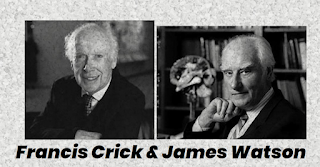Francis Crick and James Watson
The structure of DNA was well explained by Francis Crick and James Watson. It is also called as Watson-Crick model. They introduced of double helix structure of DNA
But before these two scientists, the structure of DNA was already explained by a scientist with the help of radiation. The scientist who presented the structure of DNA was Rosalind Franklin.
She takes the crystal molecules of DNA and shows images of DNA with the help of X-rays in 1950.
But she died at an earlier age and hence Watson and Crick were the two scientists who accepted the Nobel Prize with the help of another scientist, Maurice Wilkins for their structure of DNA.
Watson Crick model of DNA.
According to this model, DNA is made up of three components:
- Deoxy-ribose Sugar
- Phosphate Group
- Nitrogenous Bases
· The pentose sugar is deoxyribose because of the removal of oxygen from the ribose molecule.
· Phosphate groups form the chain of deoxyribose by connecting two deoxyribose molecules. The structure of pentose sugar and phosphate groups forms the backbone of DNA.
· Nitrogenous bases form the core structure of DNA.
There are four types of nitrogenous bases present in DNA. These are:
- Adenine
- Thymine
- Cytosine
- Guanine
- As Chargaff demonstrated, adenine binds with thymine, while cytosine mostly binds with guanine.
- These four bases are held together through hydrogen bonds.
- Two hydrogen bonds between adenine and thymine, and three hydrogen bonds between pyrimidines.
- The structure of DNA is double helical, composed of deoxyribose sugar, phosphate groups, and nitrogenous bases.
- DNA is present in the nucleus of the cell. It is present in the supercoiled form.
- If we take out the DNA from one cell and stretch it long to measure its length, the size of one DNA molecule is about 2 meters in length.
- This is a miracle of nature that such a large size of DNA is present in such a tiny and microscopic size of cell.
- The coiling was done by the histone protein that is present in the nucleus of the cell.
- The DNA wraps around the histone protein and forms chromosomes.

.png)





.png)
.png)
.png)
%C2%A0.png)
.png)

.png)

.png)

0 Comments